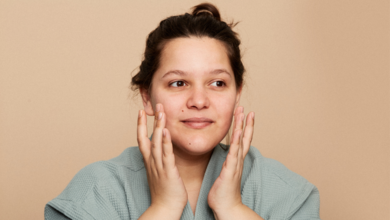The Benefits of Carotenoids for Skin
While a solid skin-care routine rich in hero ingredients like vitamin C and retinoids can keep your complexion healthy (and glowing!), it’s only one piece of a much larger puzzle. What you eat and drink can have a major impact on your skin, and studies show1 certain nutrients can improve hydration, elasticity, firmness, and brightness.
Though no single superfood promises to be a cure-all for your varying skin concerns, there’s one antioxidant currently gaining fame in the beauty world that’s capable of helping out with a whole lot of them.
Carotenoids, which are found in many plant-based foods, have begun to emerge in skin supplements and topicals thanks to their ability to defend against visible signs of aging. Read on to find out why they’re worth adding to your routine.
What are carotenoids?
“Carotenoids are the colored pigments found in nature that produce the bright yellow, red, and orange colors we see in certain fruits, vegetables, and other plants,” explains Jessica Shapiro, RD, a certified diabetes educator and the associate wellness and nutrition manager at Montefiore Medical Center in Westchester, New York. “These pigments are made by plants and cannot be made by the body, but act as powerful antioxidants when we eat them,” adds Kylie Amanda, RD, a certified surgical dietitian and nutritionist.
There are currently around 750 carotenoids that occur in nature, but Shapiro says we mainly come into contact with a select few found in fruits and vegetables that we commonly eat:
1. Alpha and beta-carotene
Found in pumpkin, plantains, carrots, sweet potato, winter squash, and green foods like spinach and collards (the chlorophyll in these greens hides the yellow-orange pigments).
2. Beta-cryptoxanthin
Found in orange and red fruit and vegetables, such as sweet red peppers and oranges.
3. Lycopene
Found in red fruits and vegetables such as tomatoes, pink grapefruit, watermelon, and guava, but more bioavailable and easily absorbed from processed foods like tomato sauce, tomato paste, and ketchup.
4. Lutein
Found in dark green leafy vegetables like spinach and kale, as well as egg yolks and avocados (which Shapiro says have low levels of lutein, but are highly bioavailable).
5. Zeaxanthin
Found in yellow corn (and corn-based products), bell peppers, and egg yolk.
How carotenoids affect the skin
Before we get into the specifics and wide-ranging benefits of carotenoids, it’s important to understand skin health, how your skin shows signs of aging, and how the ingestion of carotenoids helps to slow down or reverse this process.
Skin aging occurs as a result of both intrinsic (or internal) and extrinsic (or external) factors.“Intrinsic factors are related to your age and genetics, while extrinsic factors include lifestyle factors such as sun exposure, cigarette smoking, air pollution, [and] nutrition,” says Carmen Castilla, MD, a board-certified dermatologist in New York City.
Unlike your internal organs, your skin is directly exposed to the elements, which makes it highly vulnerable to the aging effects of environmental stressors. “Most of what we recognize as aging of the skin results from the deleterious effects of UV radiation from sun exposure,” says Richard Granstein, MD, chair of the department of dermatology at Weill Cornell Medicine and a scientific advisory board member at Elysium, a supplements brand.
UV damage causes inflammation, which leads to the formation of radical oxygen species (ROS) that disrupt the naturally occurring chemical reactions that your skin cells need to function properly. This, in turn, causes the breakdown of collagen and elastin in the skin and stimulates the production of melanin, which results in visible signs of skin aging like fine lines and wrinkles, skin laxity, and hyperpigmentation.
Adding carotenoids to your routine can help combat these effects from the inside out thanks to their antioxidant activity, which essentially allows them to gobble up those ROS’s before they can cause damage. “Carotenoids can prevent some the UV-induced damage through the absorption of UV rays and function as a free radical scavenger,” says Dr. Castilla.
Dr. Grandstein explains that ingesting carotenoids can chemically neutralize—or, stop—the effects of UV radiation on the skin, staving off signs of aging. What’s more, because carotenoids are converted to vitamin A within the body (the same vitamin that good ol’ retinol derives from), they can aid in the formation of new collagen.
How to reap the benefits of carotenoids for skin in your own routine
1. Orally
“Consuming a wide variety of brightly colored fruits and vegetables will help you naturally increase your carotenoid intake,” says Dr. Castilla.
Shapiro’s best advice is to “eat the rainbow”—specifically red, orange, and yellow varieties of plant-based foods—in both raw and cooked form. “The type of processing will affect the bioavailability of the carotenoids,” she explains, meaning that certain preparations allow for better carotenoid absorption within the body.
Additionally, because carotenoids are fat soluble, they’re most effective when taken with a meal that contains fat. “This is true for both food and supplement sources,” adds Shapiro.
Speaking of supplements, you can also get your carotenoids in capsule form “Generally, supplements contain higher concentrations of carotenoids than are consumed from a normal diet,” says Dr. Granstein. “The amount in supplements is geared towards specific endpoints.”
Shapiro recommends 2-3 servings of dietary carotenoids per day (or 20-50mg per day) for 3-6 weeks to see visible changes in the skin. “It’s difficult to consume too much with dietary sources, but be careful with supplements because it’s easy to overdo it,” she adds.
Additionally, Amanda points to research2 that shows that the carotenoids stored in our skin degrade after having a cold or virus. “Levels also drop in the winter, likely due to our lower consumption of fruits and veggies, and perhaps the quality is slightly subpar due to being out of season,” she says. “For this reason, it’s important to up your dosage in the cooler months to sustain the benefits of carotenoids.”
2. Topically
A 2021 study3 found that applying carotenoids topically is an effective way to defend against oxidative stress… just not as effective as consuming them orally.
Dr. Castilla explains that both methods increase the levels of the nutrient in the skin, but the results tend to last longer when you ingest them. “Topical carotenoids are typically stored in the stratum corneum which is the outermost layer of the skin,” she explains. “This layer is constantly renewed and shed which likely explains why the levels fall faster than [with] oral ingestion where carotenoids are stored in fat and are slowly released into the skin.”
So though ingesting carotenoids is the best way to reap their anti-aging benefits, there’s something to be said about supplementing the practice with a topical serum.
Well+Good articles reference scientific, reliable, recent, robust studies to back up the information we share. You can trust us along your wellness journey.
- Fam, V. W., Charoenwoodhipong, P., Sivamani, R. K., Holt, R. R., Keen, C. L., & Hackman, R. M. (2022). Plant-Based Foods for Skin Health: A Narrative Review. Journal of the Academy of Nutrition and Dietetics, 122(3), 614-629. Published on October 30, 2021. DOI: 10.1016/j.jand.2021.10.024.
- Darvin ME, Sterry W, Lademann J, Vergou T. The Role of Carotenoids in Human Skin. Molecules. 2011 Dec 16;16(12):10491–506. doi: 10.3390/molecules161210491. PMCID: PMC6264659.
- de Souza Guedes L, Martinez RM, Bou-Chacra NA, Velasco MVR, Rosado C, Baby AR. An Overview on Topical Administration of Carotenoids and Coenzyme Q10 Loaded in Lipid Nanoparticles. Antioxidants (Basel). 2021 Jun 26;10(7):1034. doi: 10.3390/antiox10071034. PMID: 34206935; PMCID: PMC8300771.
Our editors independently select these products. Making a purchase through our links may earn Well+Good a commission.


